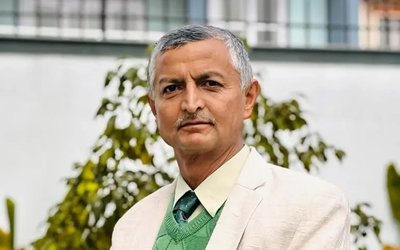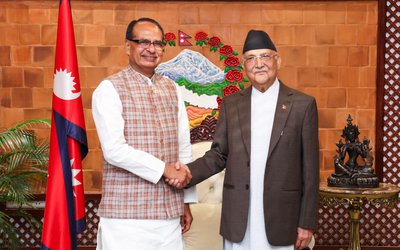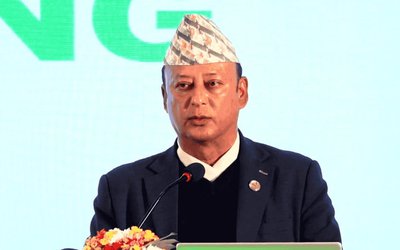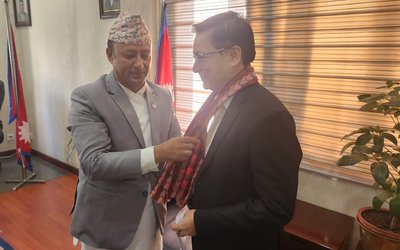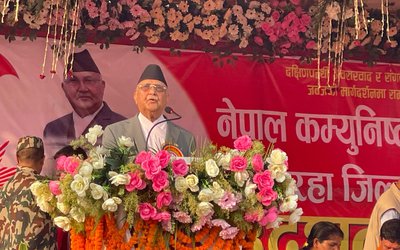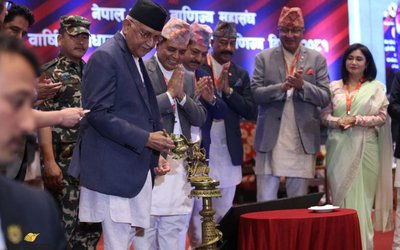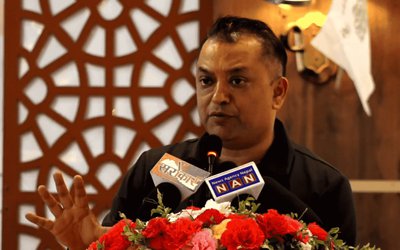
Although Nepal is one of the richest countries in terms of per-individual water availability, it is the poorest country in terms of use of water. Despite several efforts of the government, a large number of people are yet to gain regular access to safe drinking water. Nepal has already invested a huge amount of money to improve the coverage of drinking water. However, it is yet to supply regular and safe water to all. Nepal's experiences have shown that it is not the scarcity of water but the governance which matters much in the context of water supply. As Nepal is celebrating the World Water week 2013, under the theme of Water Cooperation, with the slogan ‘water, water everywhere, only if we share,’ the time has come for Nepal's policymakers to discuss how the cooperation among various stakeholders can be broadened
Jharna Manandhar, a resident of Sundhara of Lalitpur district, has to wake up twice a week early in the morning to get tap water. According to Kathmandu Valley Drinking Water Supply Limited (Kathmandu Upatyaka Khanepani Ltd (KUKL) chart, the its Lalitpur Branch releases water for two hours on Wednesday and Saturday from 2-4 AM every week.
It is the usual duty for Jharna, 28, mother of two children, to wake up at this odd early morning. When the dry season begins, people living in the valley have to face a worse situation, when the water tables go down. Like Jharna, all the people living in Kathmandu Valley have the same story to share.
As the quality of water supplied by the government owned Kathmandu Valley Water Supply Ltd is regarded as better and the price is also cheaper, every one prefers to use the water it supplies. Although there is an option to buy the water carried out by private tankers, it is ten times expensive than what people get from KUKL. For instance, people have to pay a minimum Rs.75 for first 3,000 liters of water to KUKL. However, one has to pay Rs.1000.00 for private tanker. For instance, the cost of 20 liter bottle water is about Rs. 50.00 and there is no guarantee to the water quality supplied by private companies.
Water is limited and it is scarce, thus it carries certain economic cost. However, people in Kathmandu Valley and other parts of the country consider that water is a free commodity. This is the reason KUKL is supplying the water in a much cheaper way, even at a lower rate than its own maintenance and other costs.
There is a reason to think about water in that way. In 2010, UN General Assembly passed a resolution to recognize that access to safe drinking water is a part of individual human rights. Similarly, Nepal’s Water Resources Act 1992 says that the right to use water for drinking purpose overrides the right to use the same water for any other (i.e. irrigation and commercial)purpose. The National Drinking Water Quality Standard 2005 details the standard of quality must be applied to all drinking water resources.
Although people are ready to pay the money when they have to buy water from private tankers, it is not the same with KUKL. Due to the fear of massive protest and public anger, the government is always reluctant to increase the tariff. Low tariff leads to irregular and low quality water supply. In its recent report, KUKL said that it is virtually in the process of bankruptcy due to the unpaid dues of over Rs.2 billion.
“Water is an important commodity. We focus our attention more on water for drinking purposes. We need to think of water for irrigation purposes also,” said Minister of Home Affairs and Foreign Madhav Prasad Ghimire. “We need to give the message that there is the need of cooperation from all on water sharing issue.”
State of Rural Areas
Along with Kathmandu, the situation of water supply in other parts remains the same. Even in the rural areas, people hardly share any cost. Thus, most of the water taps and water projects become non-functional within a couple of years after use. Even there, frequent duplications of the projects are common. According to a study, the lack of proper selection criteria and guidelines has caused a serious imbalance in the allocation of resources for water intervention in the districts and Village Development Committees. There are also duplications in the schemes because all the projects are being run either by the government, INGOs and donors. Of course, water supply is free as it is constructed under donor’s contribution, but it involves price to maintain pipes, repair, test quality and make the regular supply. As long as the people refuse to consider the cost, supplying water to all will not be more than a dream.
Nepal government and other international donor agencies have invested significant money in the establishment of water system in rural and urban areas. But, there are still large numbers of people without having access to safe water. Nepal plans to ensure 73 percent of water coverage by 2017 and to meet the Millennium Development Goals. However, Nepal is yet to prevent the death resulted by the supply of contaminated water.
According to the census report 2011, tap/piped water is the main source of drinking water for 47.48 percent of the total households. Tube-well and pumping is the main sources of drinking water for about 35 percent of the total households. While spout, uncovered, well/kuwa and covered well/kuwa are the main sources for 5.4 percent, 4.71 percent and 2.45 percent respectively. Decades ago, 53.4 percent of population had access to tap/piped water and 28.60 percent used tube wells and hand pumps.
According to a study undertaken by WaterAid Nepal’s update 2011, there are still some districts which have yet to achieve the target. For instance, Kaski district has 92 percent drinking water coverage followed by Kavreplanchwok, 88, with the lowest for Humla at 48 followed by Dailekh 56, Salayan 57 and Bajhang 58.
Nepal’s State of Water
Nepal's surface water is estimated to be about 225 billion Cusec meters per annum or equivalent to an average flow of 7125 billion BCM. Out of this, only 15 BCM per annum is in use. Around 95.9 percent of 15 BCM has been used for agriculture,3.8 percent for domestic purpose and only 0.3 percent for industry.
“Nepal is indeed rich in water resources. So, it’s not a matter of water not being there. The problem is that of reliability and access all the time. This problem comes from a failure of resource-related governance issues. Governance mechanisms deal with what goes where, how, who pays, who gets where, who gets subsidy, why, and other such related matters. Unless we address the governance issues, Nepal is always known as a country of potential for water and always will remain like that,” said Ashutosh Tiwari, country director WaterAid. Water can be free – but pipes, repair, quality tests , regular supply- all need costs.
According to Water and Energy Commission Report, around 78 percent of the average flow of the country is available in the first category river basins, 9 percent in the second category basins and 13 percent in the numerous small rivers of the terai.
According to WaterAid Nepal, an international non-governmental organization working in water and sanitation sector, only 80 percent of the population has access to water. This means 5.6 million are yet to have access to water. Nepal needs to allocate 7.5 billion rupees annually to meet the water needs.
However, others see water management as more important than water coverage. "Water management is very critical for the growth and development of any economy, more so in a developing country like Nepal. However, the resource is now under stress because of excessive ground water abstraction in the course of socio-economic development and meeting increasing needs of growing population. Therefore, we need to conserve this precious resource while benefiting from it.
Water Week
To commemorate World Water Day and World Meteorological Day in Nepal, different organizations, including governmental agencies, have been organizing a week of related programs since 2008 under an umbrella network of Nepal National Water Week under the leadership of Water and Energy Commission Secretariat (WECS).
The National Water Week 2013 aims to celebrate World Water Day and World Meteorological Day nationwide and advocate it in a joint effort from various sectors. The major objectives of the week are to raise awareness, both on the potential for increased cooperation and on the challenges facing water management in light of the increase in demand for water access, allocation and services. The other aim is to intensify discussions on water related issues focusing on urban water and sustainable management of water resources in Nepal.
The Water Week will be celebrated from 17 to 23 March 2013 in Nepal. Awareness, advocacy, capacity building and research oriented activities will be part of the programme. On 22 March, the World Water Day was celebrated under the theme Water Cooperation with slogan ‘water, water everywhere, only if we share.’ This day was organized as part of the International Year of Water Cooperation.
“One of the aim of the celebration is to raise awareness on the importance of freshwater and advocating for the sustainable management of freshwater resources with a special focus on water cooperation, its challenges and benefits,” said Bishwa Prakash Pandit, secretary to the Water and Energy Commission.
On 22nd March, International World Water Day is celebrated as a means of focusing on the importance of freshwater and advocating for sustainable management of freshwater resources. United Nations Conference on Environment and Development (UNCED) in 1992 recommended celebrating the day as an international day for freshwater and 22 March 1993 was designated as the first World Water Day.
More than a decade long experience has already shown that there is the need of cooperation among different stakeholders to realize the universal coverage of drinking water. As the theme said, only saying water water everywhere does not make tangible change as long as it is not shared by all.

Keshab Poudel
Poudel is the editor of New Spotlight Magazine.
- PM OLI MEETS PM MODI: No Progress
- Apr 09, 2025
- PM OLI’S THAILAND VISIT: Flip Flop
- Apr 08, 2025
- FM Dr. Deuba’s India Visit: Mission Aborted
- Mar 26, 2025
- AMBASSADOR MAEDA TORU: Warm Regards
- Mar 24, 2025
- PRO-MONARCHY MOVEMENT: Rising Dissatisfaction
- Mar 23, 2025
